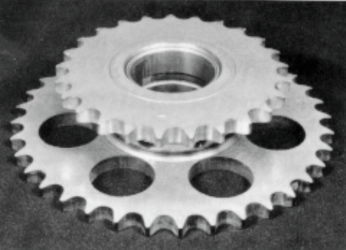Optimizing a project for powder metallurgy isn’t just a matter of pouring a mix into a Play-Doh machine and cranking it out. The sintering process in powder metallurgy alone offers several tweaks that can give you different, nuanced results.
One of the most exciting processes for those designing a complex part is called sinter bonding. In this process, the manufacturer bonds two pieces together during sintering.
The implications could be big for your project, no matter the industry.
Sinter Bonding in Powder Metallurgy
Sinter bonding allows you to:
- Reduce the number of components in your assembly
- Reduce cost due to assembly of multiple components
- Create complex shapes not typically produced with conventional processes
- Creates the opportunity to isolate a material in a specific location of a part
Before we go too deep into sinter bonding, let’s start with a refresher: What is sintering in powder metallurgy? Sintering is a heating process used after the metal powder is compacted. Compaction creates enough connections between powder particles to allow the part to be picked up and waved around, but it won’t hold up to many real-world applications.
In these cases, the “green” parts are put through a powder metallurgy sintering furnace, where temperatures up to 2000°F -- and higher -- fuse the powder particles together. The components receive enough heat to develop the necessary bonding, but not so much heat that the part melts.
Sintering is one of the most important steps in powder metallurgy, but what’s amazing about sinter bonding is being able to sinter two parts together, just like welding. This creates a single sintered metal assembly with the benefits further detailed in the next section.
Say you need one component to do one thing, but another part of it to do something else. High-wear applications and magnetic parts are great examples. Say you need a separate part of your assembly to be nonmagnetic. The only way to accomplish this besides sinter bonding is a very expensive process like laser welding.
Sintered bonding can combine any two assemblies, as long as those assemblies have the right properties. For example, you can use a nickel-iron outside and a copper-steel inside. During sintering, the copper will expand and the nickel will shrink. The differences between the two materials result in intimate contact, and the parts sinter together.
Just like that, you’ve got the best of each material.
The Unique Benefits of Sintered Bonding
There are several factors that make sinter bonding so useful:
1. Unique Shape-Making Capability
Some shapes can’t be molded, but they can be created through sinter bonding.
Think of a reduction gear assembly in which you have a large drive gear and a smaller drive gear mounted on a common shaft. Here the driven gear is turned by a motor, but you want to reduce the speed of the input … thus the smaller gear.

2. Eliminates Secondary Machining & Scrap
With proper planning and execution, you may be able to create parts that don’t require secondary machining. As a result, you can virtually eliminate scrap.
The more steps you eliminate and the less scrap you create, the more cost-competitive your part becomes.
3. Greater Strength
You’ve probably heard, “The sum of the whole is greater than its individual parts” in reference to a sports team. Sinter bonding can create a final part that’s as strong as either of the original parts.
4. Doesn’t Require Additional Elements
Creating a bond between two sintered parts doesn’t require much, besides a capable manufacturing partner. In contrast, sinter brazing requires a specific paste to ensure that parts become fused. Sinter bonding simply relies on the unique qualities of the two parts.
Complex Parts through Powder Metallurgy
One of the big advantages of powder metallurgy is the cost savings, right? Using the sintering process in powder metallurgy to bond assemblies makes it possible to create complex shapes, so you’re not required to use other, more expensive processes. Rather than having to move to machining, forging, or other labor-intensive manufacturing, you can create what you need through powder metallurgy.
The key with sintered bonding is to understand the properties of the metals you are working with so that you can ensure that the parts bond properly. This is made all the easier by working with a powder metallurgy manufacturer that’s experienced in advanced materials and sinter bonding.



